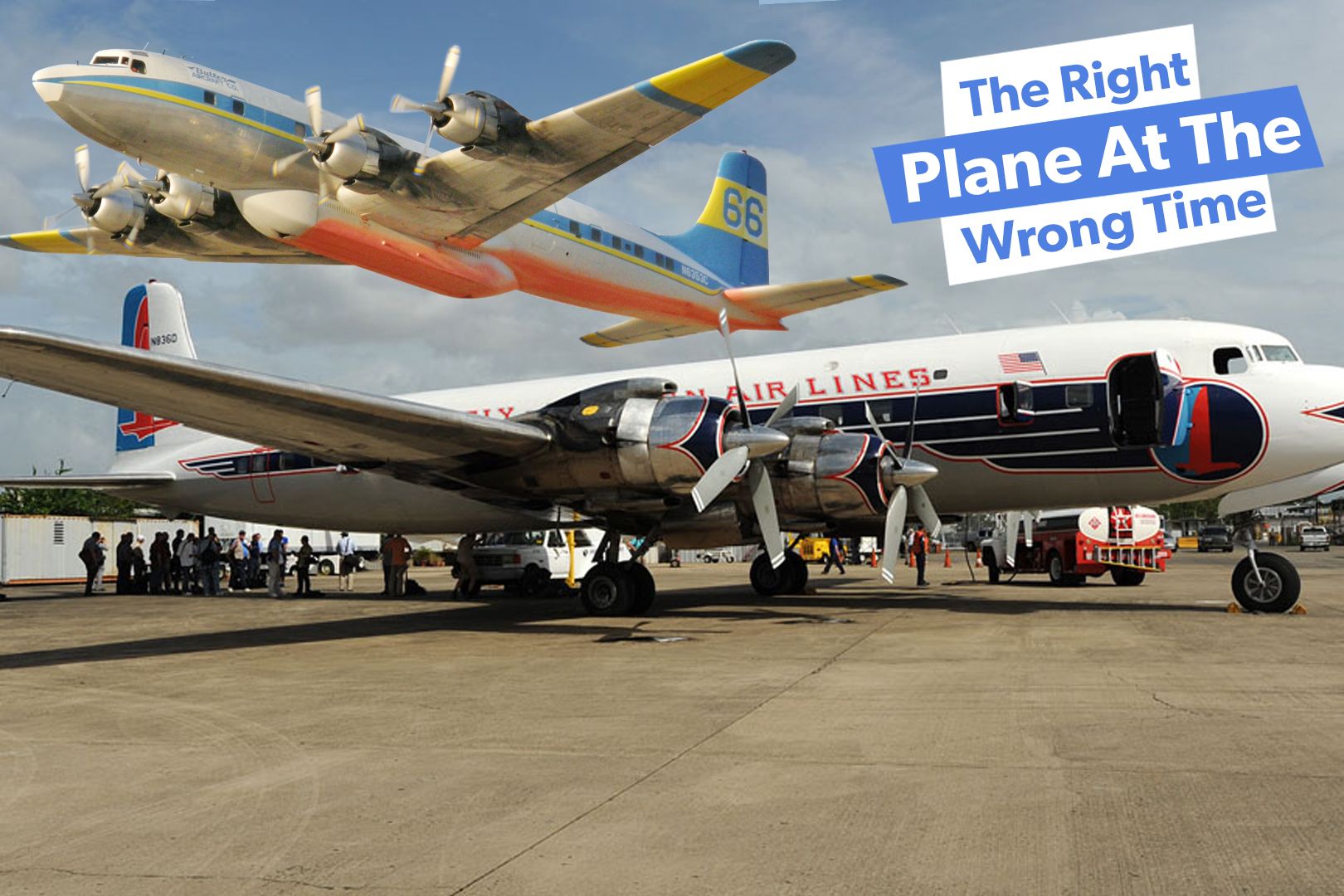Summary Douglas was initially hesitant to build the DC-7 until American Airlines committed to purchasing 25. The DC-7 revolutionized US commercial aviation by offering the first non-stop coast-to-coast flights. The aircraft was converted into a freighter as passenger demand declined, extending its lifespan.
Built by the Douglas Aircraft Company between 1953 and 1958, the DC-7 was a derivative of the DC-6, made to fly coast-to-coast across the US in as little as eight hours. The DC-7 was the last piston-engine powered plane built by Douglas, and no examples of the aircraft are still flying today. Douglas was initially reluctant to build the DC-7 As the Second World War drew to a close, Pan American World Airways approached Douglas, requesting a civilian version of the company's C-74 Globemaster military transport aircraft.

However, Pam Am later canceled its order for what was initially designated as the DC-7, and the name went unused for the time being. Nonetheless, the idea resurfaced for an aircraft with the DC-7 designation when American Airlines asked for a plane that could fly coast to coast non-stop. However, Douglas was initially reluctant to build the aircraft until American Airlines ' President C.
R. Smith said he wanted 25 of them. The deal would be worth $40 million to Douglas, which was enough to cover the initial development costs.
Love aviation history ? Discover more of our stories here! Slightly larger than the popular Douglas DC-6 model, the DC-7 would be powered by four eighteen-cylinder Wright R-3350 Duplex-Cyclone Turbo-Compound engines. According to Airways Magazine , the first prototype of the aircraft took to the skies over 70 years ago, on May 18th, 1953. American Airlines then took delivery of its first DC-7 in November of that year.
American Airlines was the first to offer non-stop coast-to-coast flights The DC-7's transcontinental capabilities made it a game-changing aircraft for US commercial aviation. American Airlines offered the first non-stop coast-to-coast flights in the country using the aircraft. Rival airline TWA was then forced to provide a similar service using its Lockheed L-1049 Super Constellations.
Because commercial pilots were not permitted to fly for more than eight hours, they needed to push the limit of the engines to make the journey in the specified time frame. However, the engines had the potential to overheat and fail as a result of this exertion, which caused certain flights to be diverted to the nearest airfield. Offering slightly more power than older models, Douglas subsequently built the DC-7B, which Pan Am used in the summer of 1955 for transatlantic flights.
By using the DC-7Bs, Pan Am could fly from New York to London or Paris one hour forty-five minutes faster than airlines that chose to operate Boeing 's 377 Stratocruisers. Meanwhile, the type also found commercial success in Europe. Indeed, fed up with waiting for its Bristol Britannia aircraft to be delivered, in 1956, BOAC decided to purchase the DC-7.
According to This Day In Aviation , SAS used it elsewhere on some of its polar routes to North America and Asia. The DC-7 was introduced by the Nordic carrier on its Copenhagen to Tokyo (via Anchorage) route. The DC-7 helped reduce these long-haul journeys by 2,000 mi (3,219 km).
It also cut the duration by 18 hours to a total of 32 hours. The type sold better than the Lockheed L-1649A Starliner, although its sales ultimately collapsed when the jet-engined Boeing 707 and Douglas DC-8 entered service in 1958 and 1960. There are still some operators of these models today.
A prominent operator of the DC-7 was Delta Air Lines. The Atlanta-based carrier entered its aircraft into scheduled service in April 1954. The operator was a fan capacity and the weight savings to be had with the plane over previous models.
The airline shared the following, as per the Delta Flight Museum : “The longer length of the DC-7 and DC-7B fuselage (over eight feet more than the DC-6), allowed room for an eight-passenger Sky Room, with facing seats, and a five-seat Sky Lounge, in addition to two main cabins. Delta's DC-7 and DC-7B initially held 69 passengers in all first-class seating, except for four DC-7B which were delivered in 1957 with all-coach configuration for 90 passengers. Improvements in air conditioning and sound proofing provided additional comfort.
” Other major commercial operators over the years included: Eastern Air Lines Northwest Orient Airlines KLM Sabena United Airlines. Douglas began converting DC-7s into freighters As passenger demand for the type began to dwindle, Douglas began converting certain passenger-configured DC-7s into the cargo-carrying DC-7F in 1959 to extend the plane's lifespan. In order to complete this procedure, certain cabin windows were removed, and the aircraft was fitted with large rear and forward freight doors.
In total, Douglas built four variants of the DC-7, with one more unbuilt model: DC-7 - The first model, of which 105 examples were built. DC-7B - A long-range variant with larger fuel tanks, of which 112 examples were built. DC-7C 'Seven Seas' - An even longer-range variant that was capable of making non-stop transatlantic flights, of which 121 examples were built DC-7D - A variant that was to be fitted with Rolls-Royce Tyne turboprops, but never got built DC-7F - A freight variant of all three production models.
Get all the latest aviation news for North America here. Unlike some of its successors , there are no operational DC-7s flying today, but three are on display: N381AA is on display at the Epic Flight Academy in New Smyrna Beach, Florida. N4887C is on display at the Delta Flight Museum in Atlanta, Georgia.
EC-BBT is on display at the Real Aeroclub de Gran Canaria in Spain's Canary Islands..



















